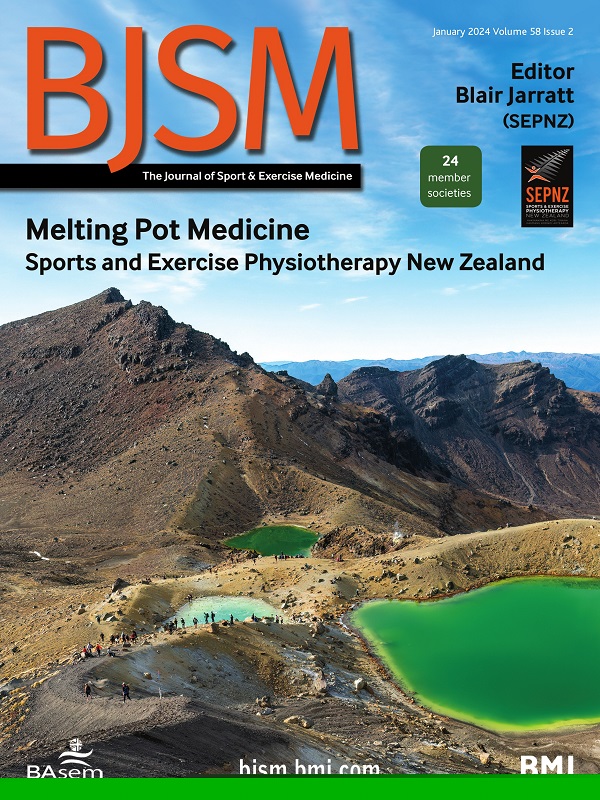背痛知识与信念调查(BacKS):开发与测量特性评估
IF 11.6
1区 医学
Q1 SPORT SCIENCES
引用次数: 0
摘要
目的 开发并评估一种新的患者报告结果测量法(PROM),以评估人们对腰背痛的认识和信念。方法 本研究遵循基于共识的健康测量工具选择标准指南。根据以证据为基础的关键信息和当前的腰背痛临床指南,制作了 18 个项目的腰背痛知识和信念调查 (BacKS) 初版。根据三位消费者和七位专家的意见,增加了四个项目。焦点小组(9 人)确认了内容的有效性。258 名澳大利亚成年人(18 岁以上)完成了 22 个项目的版本,并自述有腰背痛。一周后进行了后续调查。在制作和评估 BacKS 最终版本时,对以下测量属性进行了评估:结构效度(探索性因子分析);内部一致性(克朗巴赫α);测试-再测可靠性(类内相关系数);测量误差(最小可测变化);构建效度(假设检验:BacKS 与背部信念问卷之间存在适度的皮尔逊正相关);以及可解释性和可行性。结果 最终的 BacKS 包括 20 个项目,具有双因子结构(生物医学因子:9 个项目,得分范围为 9-45 分;自我保健因子:11 个项目,得分范围为 11-55 分)。每个因子的内部一致性和信度均符合要求(大于 0.70)。可检测到的最小变化为 4.4(生物医学因子)和 7.0(自我保健因子)。我们的构造效度假设得到了证实(Pearson 相关性=0.53)。没有发现最低或最高效应。结论 BacKS 是一种有效、可靠和可行的 PROM,可用于测量临床实践和研究环境中有关腰背痛的知识和信念。如有合理要求,可提供相关数据。本文章由计算机程序翻译,如有差异,请以英文原文为准。
Back pain Knowledge and beliefs Survey (BacKS): development and assessment of measurement properties
Objective To develop and evaluate a new patient-reported outcome measure (PROM) to assess people’s knowledge and beliefs about low back pain. Methods This study followed the COnsensus-based Standards for the selection of health Measurement INstruments guidelines. An 18-item preliminary version of the Back pain Knowledge and beliefs Survey (BacKS) was generated based on evidence-based key messages and current clinical guidelines for low back pain. Four items were added following input from three consumers and seven experts. Focus groups (n=9) confirmed content validity. The 22-item version was completed by 258 Australian-based adults (>18 years) with self-reported low back pain. A follow-up survey was sent 1 week later. The following measurement properties were evaluated to produce, and then assess the final version of BacKS: structural validity (exploratory factor analysis); internal consistency (Cronbach’s alpha); test–retest reliability (intraclass correlation coefficient); measurement error (Smallest Detectable Change); construct validity (hypothesis tested: moderate positive Pearson correlation between BacKS and Back Beliefs Questionnaire); plus, interpretability and feasibility. Results The final BacKS comprised 20 items with a 2-factor structure (biomedical factor: 9 items, score ranging from 9 to 45, and self-care factor: 11 items, score ranging from 11 to 55). Internal consistency and reliability were adequate (>0.70) for each factor. Smallest detectable change was 4.4 (biomedical factor) and 7.0 (self-care factor). Our construct validity hypothesis was confirmed (Pearson correlation=0.53). No floor or ceiling effects were detected. Conclusion The BacKS is a valid, reliable and feasible PROM to measure knowledge and beliefs about low back pain in clinical practice and research settings. Data are available on reasonable request.
求助全文
通过发布文献求助,成功后即可免费获取论文全文。
去求助
来源期刊
CiteScore
27.10
自引率
4.90%
发文量
217
审稿时长
3-8 weeks
期刊介绍:
The British Journal of Sports Medicine (BJSM) is a dynamic platform that presents groundbreaking research, thought-provoking reviews, and meaningful discussions on sport and exercise medicine. Our focus encompasses various clinically-relevant aspects such as physiotherapy, physical therapy, and rehabilitation. With an aim to foster innovation, education, and knowledge translation, we strive to bridge the gap between research and practical implementation in the field. Our multi-media approach, including web, print, video, and audio resources, along with our active presence on social media, connects a global community of healthcare professionals dedicated to treating active individuals.

 求助内容:
求助内容: 应助结果提醒方式:
应助结果提醒方式:


